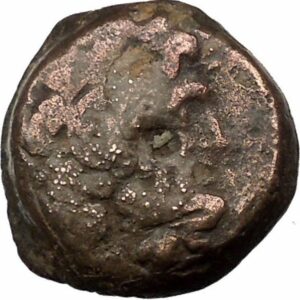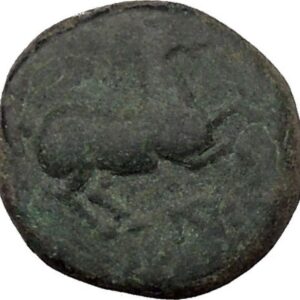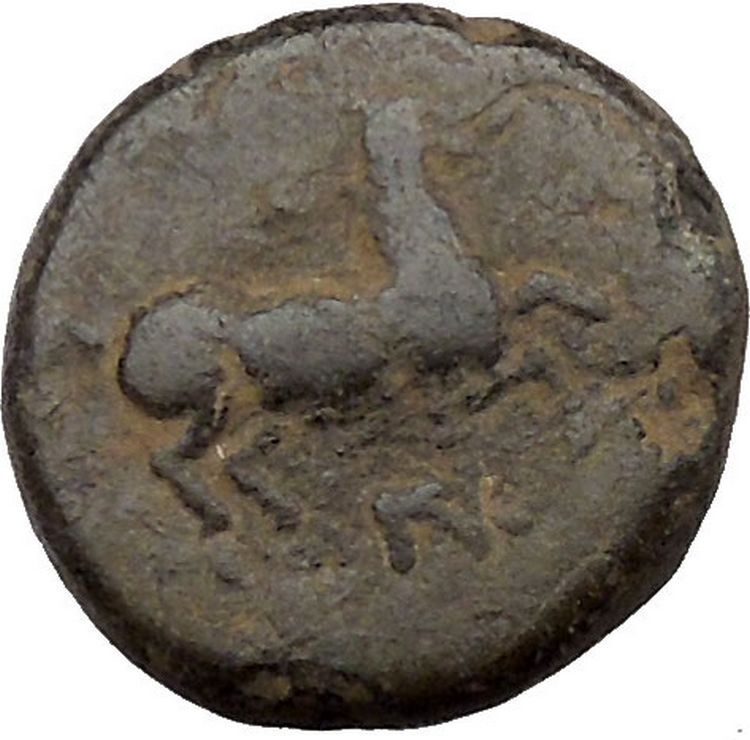|
Jewish Coin of
Alexander Jannaeus –
Jewish King of the Hosmonean Kingdom 103-76 B.C.
Bronze Prutah 13mm (2.02 grams) mint of
Jerusalem
circa 103-76 B.C.
Reference: Hendin 1149
Paleo-Hebrew (Yehonatan the High Priest and the Council of the Jews) within wreath.
Double cornucopia adorned with ribbons, pomegranate between horns, border of
dots.
* Numismatic Note: This type of coin is known to bible history
as the “Widow’s
Mite“.
You are bidding on the exact item pictured,
provided with a Certificate of Authenticity and Lifetime Guarantee of
Authenticity.
The Lesson (or Parable) of the widow’s mite is a story
present in the
Synoptic Gospels
(Mark
12:38-44,
Luke 20:45-47
,21:1-4),
in which Jesus
is
teaching at the
Temple in Jerusalem
. The Gospel of Mark specifies that a mite was
worth less than a
quadrans
,
the smallest Roman coin, implying that Mark’s intended audience were more
familiar with Roman culture than with Jewish.
In Jesus’ times there actually was no coin called a mite. However, there was
a mite in the time of the King James translation. The denomination is well known
in the Southern Netherlands. Both the
duke of Brabant
and the
count of Flanders
issued them and they were sometimes imitated in the North.
Originally, the Brabant mijt (maille in French) was 1/76 stuiver, the Flemish
mijt 1/48 stuiver. When the two areas were united under the dukes of Burgundy
and later under the Habsburgs, the rate of the mijt was set at 1/32 stuiver.
More important, they were the very smallest copper coins. By 1611 they were no
longer made, but they still circulated.
It was almost a social obligation to give a silver coin at church
collections, for there were many framed money galleries and armored safes that
needed to be filled. Only the very poor could get away with giving a copper coin
and only the desperately poor would give a copper coin as small as a mijt, as
their social status could hardly sink any lower. A widow would in principle have
to live without any income. The translator probably had a beggar and a
contemporary widow in mind. In 1611, all this would have been self-evident to
the readers.
Witnessing the donations made by the rich men, Jesus highlights how a poor
widow
donates
only two mites, the least valuable
coins available at
the time. But, Jesus observes, this sum was everything she had to her name,
while the other people give only a small portion of their own wealth.
Taken literally, the widow’s donation of one mite could have been by
obligation, since she could not have given any less. Following this reasoning,
some interpreters note that Jesus sits down in judgment “opposite” (over
against, in opposition to) the treasury; the lesson drawn emphasizes that, while
people are impressed with the large sums that are put in, they did not notice
that the temple took half of what the “poor widow” had to live on. Connected
with Mark 13:1-2, “there will not be left one stone upon another, that will not
be thrown down”, the lesson is then interpreted as promising the overthrow of
any worship of God sustained by robbery.
However, since the woman would have been under no obligation to give the
second mite, when she gave “all her living” she could not have given any more.
Following this reasoning, the tale is typically understood by Christians as a
condemnation of the rich as they are described, for their inflated self
importance displayed by the ostentatious announcements of their own generosity:
which Jesus dwarfs by comparison to the widow’s mite. Also, in light of its
proximity to the widow’s mite story, Mark 13:1-2 may imply that the widow’s
worship is of greater value than the Temple. Accordingly, the story is typically
taken as an admonition to be wholeheartedly devoted to God, rather than
concerned with pleasing men.
In earlier times, many Christians, especially the
Gnostics
Ebionites
,
Waldensians
, and
Franciscans
,
argued that the passage is an encouragement to live in poverty, and not seek
riches. In the introduction to the passage, Jesus is portrayed as condemning the
Pharisees who feign piety in order to gain the trust of
widows
, and
thereby gain access to their assets; although most interpretations of this read
it as criticism of the actions of certain individuals,
racist
groups have historically argued that the passages in question justify
anti-semitism
, particularly as the Gospel of Mark argues that severe
punishment awaits those who follow such actions (Brown et al.).
Alexander Jannaeus (also known as Alexander Jannai/Yannai), king
of Judea
from
(103 BCE to 76 BCE), son of
John
Hyrcanus
, inherited the throne from his brother
Aristobulus
, and appears to have married his brother’s widow, Shlomtzion
or “Shelomit”, also known as
Salome Alexandra
, according to the Biblical law of Yibum (“levirate
marriage”), although
Josephus
is
inexplicit on that point.

Hasmonean Kingdom under Alexander Jannaeus
situation in 103 BC area
conquered
His likely full Hebrew name was Jonathan; he may
have been the High Priest Jonathan, rather than his great-uncle of the same
name, who established the
Masada
fortress. Under the name King Yannai, he appears as a wicked tyrant in the
Talmud
,
reflecting his conflict with the
Pharisee
party. He is among the more colorful historical figures, despite
being little known outside specialized history. He and his widow (who became
queen
regnant
after his death) had substantial impact on the subsequent
development of Judaism.
Jannaeus expanded the Hasmonean Kingdom and established the city of
Gamla
in 81 BCE
as the capital for the
Golan
Heights
.
Conquests of Alexander Jannaeus
During the twenty-seven year reign of Alexander Jannaeus, he was almost
constantly involved in military conflict. Primarily, international factors at
the time created an environment suitable for Jannaeus’ conquests. First of all,
Jannaeus received support from Cleopatra III in Egypt. She was probably swayed
to support Jannaeus through two Jewish commanders in her military. This support
was particularly crucial during the war with Ptolemy Lathyrus (discussed later).
Ultimately, conflict in the Roman Empire was the greatest outside influence on
Judean military campaigns. Political instability in Rome led to a Civil War
beginning in 88 BCE. With Rome chiefly concerned with a tumultuous domestic
predicament, Jannaeus was free to expand the Judean state. Finally, a weak
Seleucid Empire was unable to help Hellenistic cities near Judea.
With a mercenary army similar to that of his father, Jannaeus led a Judean
army that conquered the entire coastal plain except for Ashkelon. Jannaeus
toppled Western Samaria, the Galilee and the Northern Transjordan. The coastal
ports of Dor and Caesarea were also taken after Jannaeus was defeated at Acre.
Elsewhere on the Mediterranean coast, the Judeans triumphed over the cities of
Raffah and Antedon. Finally, Jannaeus outlasted the inhabitants of Gaza in a
year long siege. This impressive victory gained Judean control over the
Mediterranean outlet for the Nabatean trade routes.
War with Ptolemy Lathyrus
After a failed siege against Gaza, Jannaeus struck a phony league of
friendship with the Egyptian co-ruler
Ptolemy Lathyrus
. In reality Jannaeus sought the assistance of Lathyrus’
mother,
Cleopatra III
, against her son. When Lathyrus learned of this treachery, he
took out his fury on Judea. After defeating Jannaeus near the Jordan River,
Lathyrus’ soldiers slaughtered fleeing Jewish troops. Afterwards, Lathyrus
attacked a small village in Judea with utter malice. The Egyptian troops
strangled women and children. Then the deceased were cut into pieces, boiled in
cauldrons, and eaten as a sacrifice. This disgusting act of cannibalism was used
to terrify the Judean people and their military. After this massacre, Jannaeus
was in no position to stop the onslaught of Lathyrus. However, Cleopatra III
stepped in to prevent Lathyrus from sacking Jerusalem.
News of this slaughter certainly spread rapidly throughout Judea, exemplified
by the Pesher on Isaiah 4Q161 found at Qumran: “(25) He will shake his fist at
the mount of the daughters of Zion, the hill of Jerusalem…(27) when he goes up
from the Valley of Acco to fight against Philistia…(29) and even up to the
boundaries of Jerusalem.”
High Priesthood
It is clear that a strong rift existed between the Pharisees and Alexander
Jannaeus. The rival Sadducees were avid supporters of Jannaeus (see 4Q448). The
Pharisaic opposition to Jannaeus continued with his marriage to his brother’s
widow, which was forbidden by Torah law. Furthermore, Jannaeus established
himself as a ruler concerned mainly with conquests rather than his religious
obligations.
One year during the Jewish holiday of Sukkot, Alexander Jannaeus, while
officiating as the High Priest (Kohen Gadol) at the Temple in Jerusalem,
demonstrated his support of the Sadducees by denying the law of the water
libation. The crowd responded with shock at his mockery and showed their
displeasure by pelting Alexander with the
etrogim
(citrons)
that they were holding in their hands. Unwittingly, the crowd had played right
into Alexander’s hands. He had intended to incite the people to riot and his
soldiers fell upon the crowd at his command. The soldiers slew more than 6,000
people in the Temple courtyard.
This incident during Tabernacles was a major factor leading up to the Judean
Civil War by igniting popular opponents of Jannaeus. A Qumran document sheds
further light on another opponent of Jannaeus. The scroll 4Q390 was written by
an adversary of Jannaeus seeking popular support to overthrow the Hasmonean
King. The author called for an end to the dispute between Jannaeus and the
Pharisees. According to the author, the only acceptable solution was an end to
the Hasmonean Priesthood and secular control. This opposition culminated in the
Judean Civil War.
Judean Civil War and the Crucifixion of the 800
The Judean Civil War initially began after the conquest of Gaza by Jannaeus.
Due to Jannaeus’ victory at Gaza, the Nabatean kingdom no longer controlled
their trade routes to Rome and Damascus. Therefore Nabatean king Obadas I
launched an attack on Judea in the Golan. Potentially, the war with the
Nabateans was the last straw against a war-mongering king and an incompetent
High Priest. After Jannaeus was defeated in battle against Obadas, he returned
to fierce Jewish opposition in Jerusalem. A civil war broke out between
Pharisaic supported Jewish rebels and Jannaeus.
Overall, the war lasted six years and left 50,000 Judeans dead. After
Jannaeus succeeded early in the war, the rebels unbelievably asked for Seleucid
assistance. Judean insurgents joined forces with Demetrius III to fight against
Jannaeus. The Seleucid forces defeated Jannaeus at Schechem and forced him into
exile in the mountains. However, these Judean rebels ultimately decided that it
was better to live under a terrible Jewish king than backtrack to a Seleucid
ruler. After 6,000 Jews returned to Jannaeus, Demetrius was defeated. The end of
the Civil War brought a sense of national solidarity against Seleucid influence.
Nevertheless, Jannaeus was uninterested in reconciliation within the Judean
State.
The aftermath of the Judean Civil War consisted of popular unrest, poverty
and grief over the fallen soldiers on both sides. The greatest impact of the war
was the victor’s revenge. Josephus reports that Jannaeus brought 800 rebels to
Jerusalem and had them crucified. Even worse, Jannaeus had the throats of the
rebel’s wives and children cut before their eyes as Jannaeus ate with his
concubines.
This incredible account is supported in the Dead Sea Scrolls. In the Nahum
Pesher, the Judean Civil War and Jannaeus’ brutal retribution are specifically
mentioned.
“(2) The interpretation of it concerns Demetrius, King of Greece, who sought
to enter Jerusalem on the advice of the Seeker-After-Smooth-Things. (3) But God
did not give Jerusalem into the power of the Kings of Greece from Antiochus
until the rise of the rulers of the Kittim… (6b) Its interpretation concerns the
Lion of Wrath (7) which will bring vengeance against the
Seekers-After-Smooth-Things; he would hang men alive.”
In this passage, The Seekers-After-Smooth-Things represent the Jewish Rebels,
the Lion of Wrath represents Alexander Jannaeus, and the rulers of Kittim
signify the Roman Empire. Given that this passage mentions the Roman takeover,
it was clearly written after the fall of the Hasmonean Dynasty. Nevertheless,
substantiation of Josephus’ account of the crucifixion of Jewish rebels by
Jannaeus quells any doubt of historicity of this event.
Coinage
The coinage of Alexander Jannaeus is characteristic of the early Jewish
coinage in that it avoided human or animal representations, in opposition to the
surrounding Greek, and later Roman types of the period. Jewish coinage instead
focused on symbols, either natural, such as the
palm treee
, the
pomegranate
or the star, or man-made, such as the
Temple
, the
Menorah
, trumpets or
cornucopia
Alexander Jannaeus was the first of the Jewish kings to introduce the
“eight-ray star” or “eight-spoked wheel” symbol, in his
bronzee
“Widow’s
mite” coins, in combination with the widespread
Seleucid
numismatic symbol of the anchor. These coins are thought to be the
ones referred to in the
Bible
in Luke
21:1-4:
-
“and Jesus sat over against the treasury, and beheld how the people
cast money into the treasury; and many that were rich cast in much. And He
called unto him His disciples, and saith unto them, Verily I say unto you,
that this poor widow hath cast more in, than all they which have cast into
the treasury: For all they did cast in of their abundance; but she of her
want did cast in all that she had”
Depending on the make, the star symbol can be shown with straight spokes
connected to the outside circle, in a style rather indicative of a wheel. On
others, the spokes can have a more “flame-like” shape, more indicative of the
representation of a star within a diadem.
It is not clear what the wheel or star may exactly symbolize, and
interpretations vary, from the morning star, to the sun or the heavens. The
influence of some
Persian
symbols of a star within a diadem, or the eight-spoked
Buddhist
wheel (see the coins of the
Indo-Greek
king
Menander I
with this symbol) have also been suggested. The eight-spoked Macedonian star (a
variation of which is the
Vergina
Sun
), emblem of the royal
Argead dynasty
and the ancient kingdom of
Macedonia
, within a Hellenistic
diadem
symbolizing royalty (many of the coins depict a small knot with two
ends on top of the diadem), seem to be the most probable source for this symbol.
|









